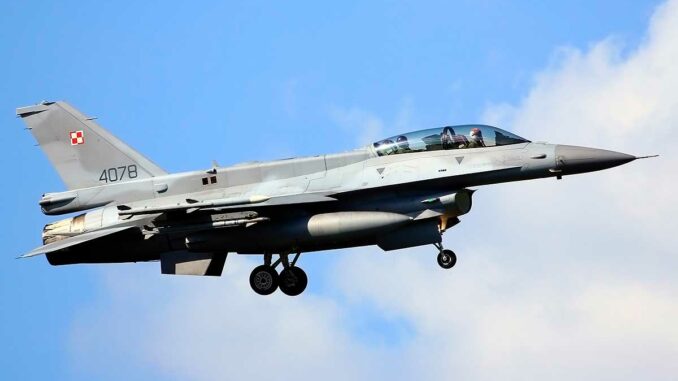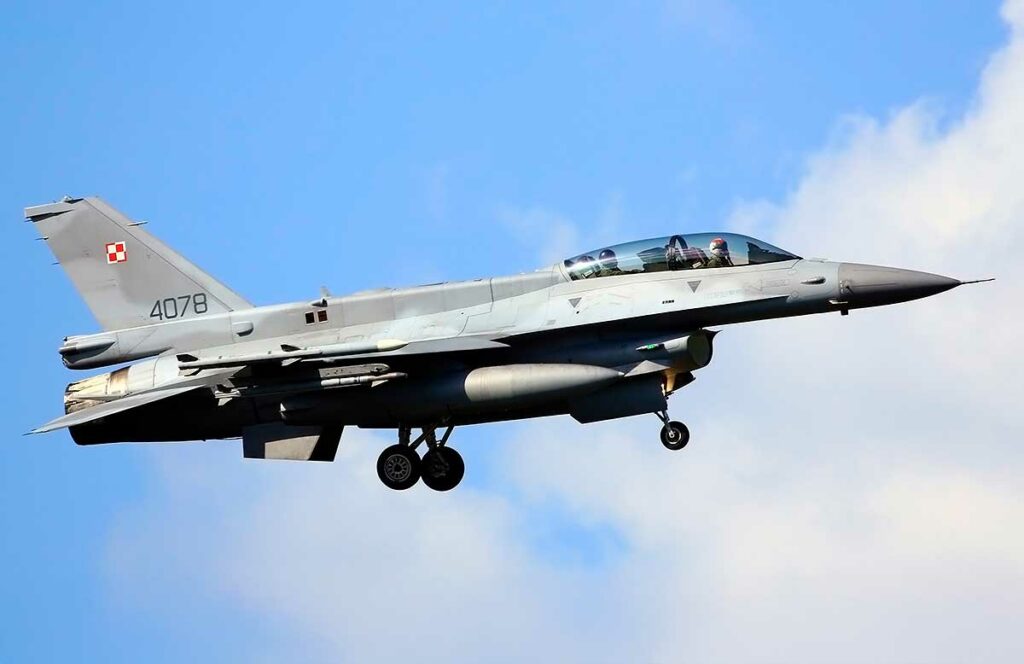
Poland is investing $3.8 billion to upgrade its 48 F-16s to the Viper version. Find out about the improvements, the strategic challenges, and the impact for NATO.
The modernization of Poland’s F-16s: a strategic challenge
Poland is strengthening its military capabilities by upgrading its fleet of 48 F-16 Block 52+ fighters to the advanced F-16V Viper configuration. This $3.8 billion investment, signed with the United States, aims to position Poland among the top three NATO nations in terms of operational capabilities, according to Władysław Kosiniak-Kamysz, Deputy Prime Minister and Minister of Defense. This initiative comes amid heightened regional tensions, particularly with Russia, and strengthens interoperability with NATO allies.
The objectives of the modernization
The modernization of the Polish F-16s responds to several imperatives. After 20 years of service, the capabilities of the F-16C/D Block 52+ are considered insufficient to face modern threats. The upgrade to the Viper version improves reconnaissance, communications, integration with other platforms such as the F-35, Abrams tanks and Apache helicopters, as well as the ability to operate in all areas of combat. This transformation also extends the service life of the aircraft to 12,000 flight hours, or approximately 60 years of operation with an average of 200 flight hours per year.
Technical improvements to the F-16V
The F-16V configuration incorporates state-of-the-art technologies to enhance the aircraft’s combat power and survivability. The main improvements are as follows:
- APG-83 AESA radar: This active electronically scanned array radar provides better target detection, even in cluttered environments, and increased resistance to jamming.
- High-resolution central display: The new display system improves pilots’ situational awareness.
- Modernized mission computers: These enable faster data processing and better system integration.
- Integrated helmet-mounted displays: These devices facilitate accurate targeting and real-time information management.
- Sniper targeting pod: Equipped with a digital video interface, it improves strike accuracy.
- Electronic warfare enhancements: These systems strengthen protection against electronic threats.
- Communications equipment: This ensures better connectivity with allied forces.
These modifications make the F-16V comparable to fifth-generation fighters in certain missions, while remaining more economical than platforms such as the F-35.
Local implementation
The program, led by Lockheed Martin, is being carried out in partnership with the Polish company Military Aviation Works No. 2 in Bydgoszcz. The modernization of the 48 aircraft will take place mainly in Poland, with flight tests for two aircraft in the United States. The work, scheduled between 2030 and 2038, includes the delivery of simulators, the construction of warehouses for sensitive parts, the supply of spare parts, and US technical support. This approach strengthens the Polish defense industry and reduces dependence on foreign infrastructure.

The strategic context
Poland, a model member of NATO, is positioning itself as a key player in Eastern Europe. Its fleet of F-16s, consisting of 32 F-16C and 16 F-16D Jastrząb (Falcon) aircraft, is divided between the air bases at Poznań-Krzesiny (31st Tactical Air Base) and Łask (32nd Tactical Air Base). Delivered between 2006 and 2008, these aircraft have reached half of their initial service life of 8,000 flight hours. The modernization extends their operational relevance against potential adversaries, notably Russia, whose air forces and anti-aircraft systems remain a threat.
Enhanced cooperation with the United States
The program is supported by US Foreign Military Financing, providing Poland with favorable loan guarantees totaling $11 billion. This collaboration illustrates the close alliance between Warsaw and Washington. Poland, which invests around 4% of its GDP in defense (one of the highest rates in NATO), is demonstrating its commitment to strengthening the collective security of the Alliance.
Challenges and limitations of the program
Despite its ambitions, the program faces several constraints:
- Long lead times: The modernization will take eight years (2030-2038), which could limit the availability of aircraft in the short term.
- High costs: At a cost of $3.8 billion, the program represents a major investment, requiring rigorous management to avoid budget overruns.
- Technical complexity: Integrating advanced systems into an existing platform requires specialized expertise and extensive testing.
- **Evolving threats: Technological advances by adversaries, such as Russia’s S-400 anti-aircraft systems, require continuous adaptation of the F-16V’s capabilities.
Implications for NATO
The modernization of Poland’s F-16s strengthens NATO’s deterrence against regional threats. By improving its multi-role combat capabilities, Poland can better contribute to Alliance missions, such as Baltic airspace surveillance and operations in the Black Sea. This initiative is in line with NATO’s priorities, which seek to modernize its forces in the face of technologically advanced adversaries.
A regional ambition
By aiming to become one of NATO’s top three nations, Poland is asserting its role as a regional leader. This modernization, combined with the acquisition of F-35s, Apaches, and Abrams tanks, makes the Polish army a modern and versatile force. It also strengthens security in Eastern Europe, which is particularly exposed to tensions with Russia.
Future prospects
The transition to the F-16V positions Poland as a leading military player until 2060, thanks to the aircraft’s extended service life. However, the program’s success will depend on Warsaw’s ability to manage costs, train personnel, and adapt to technological developments. In the long term, Poland could consider investing in combat drones or next-generation fighter jets to complement its fleet.
A step toward regional supremacy
The modernization of Poland’s F-16s is a strategic investment to strengthen national security and regional influence. It illustrates Poland’s commitment to playing a leading role within NATO, while consolidating its partnership with the United States. Although challenging, this program positions Warsaw as a key player in European defense.
War Wings Daily is an independant magazine.